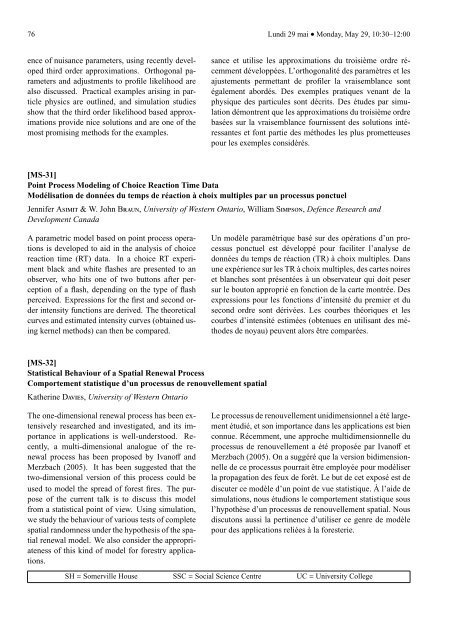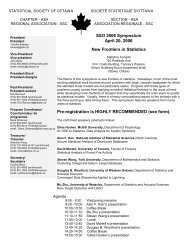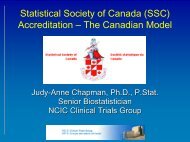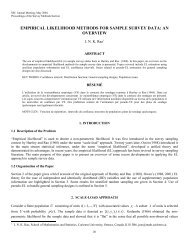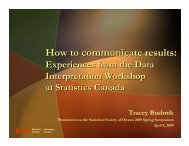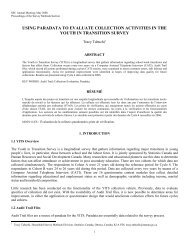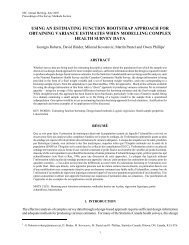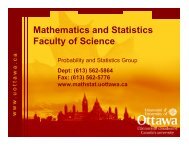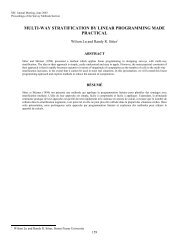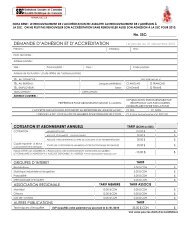Programme et résumés (pdf) - Société statistique du Canada
Programme et résumés (pdf) - Société statistique du Canada
Programme et résumés (pdf) - Société statistique du Canada
You also want an ePaper? Increase the reach of your titles
YUMPU automatically turns print PDFs into web optimized ePapers that Google loves.
76 Lundi 29 mai • Monday, May 29, 10:30–12:00sance <strong>et</strong> utilise les approximations <strong>du</strong> troisième ordre ré-cemment développées. L’orthogonalité des paramètres <strong>et</strong> lesajustements perm<strong>et</strong>tant de profiler la vraisemblance sontégalement abordés. Des exemples pratiques venant de laphysique des particules sont décrits. Des études par simu-lation démontrent que les approximations <strong>du</strong> troisième ordrebasées sur la vraisemblance fournissent des solutions inté-ressantes <strong>et</strong> font partie des méthodes les plus prom<strong>et</strong>teusespour les exemples considérés.ence of nuisance param<strong>et</strong>ers, using recently developedthird order approximations. Orthogonal param<strong>et</strong>ersand adjustments to profile likelihood arealso discussed. Practical examples arising in particlephysics are outlined, and simulation studiesshow that the third order likelihood based approximationsprovide nice solutions and are one of themost promising m<strong>et</strong>hods for the examples.[MS-31]Point Process Modeling of Choice Reaction Time DataModélisation de données <strong>du</strong> temps de réaction à choix multiples par un processus ponctuelJennifer ASIMIT & W. John BRAUN, University of Western Ontario, William SIMPSON, Defence Research andDevelopment <strong>Canada</strong>A param<strong>et</strong>ric model based on point process operationsis developed to aid in the analysis of choiceUn modèle paramétrique basé sur des opérations d’un processusponctuel est développé pour faciliter l’analyse dereaction time (RT) data. In a choice RT experi- données <strong>du</strong> temps de réaction (TR) à choix multiples. Dansment black and white flashes are presented to an une expérience sur les TR à choix multiples, des cartes noiresobserver, who hits one of two buttons after per- <strong>et</strong> blanches sont présentées à un observateur qui doit peserception of a flash, depending on the type of flash sur le bouton approprié en fonction de la carte montrée. Desperceived. Expressions for the first and second or- expressions pour les fonctions d’intensité <strong>du</strong> premier <strong>et</strong> <strong>du</strong>der intensity functions are derived. The theor<strong>et</strong>ical second ordre sont dérivées. Les courbes théoriques <strong>et</strong> lescurves and estimated intensity curves (obtained us- courbes d’intensité estimées (obtenues en utilisant des méingkernel m<strong>et</strong>hods) can then be compared. thodes de noyau) peuvent alors être comparées.[MS-32]Statistical Behaviour of a Spatial Renewal ProcessComportement <strong>statistique</strong> d’un processus de renouvellement spatialKatherine DAVIES, University of Western OntarioThe one-dimensional renewal process has been extensivelyresearched and investigated, and its im-Le processus de renouvellement unidimensionnel a été largementétudié, <strong>et</strong> son importance dans les applications est bienportance in applications is well-understood. Re- connue. Récemment, une approche multidimensionnelle <strong>du</strong>cently, a multi-dimensional analogue of the re- processus de renouvellement a été proposée par Ivanoff <strong>et</strong>newal process has been proposed by Ivanoff and Merzbach (2005). On a suggéré que la version bidimension-Merzbach (2005). It has been suggested that the nelle de ce processus pourrait être employée pour modélisertwo-dimensional version of this process could be la propagation des feux de forêt. Le but de c<strong>et</strong> exposé est deused to model the spread of forest fires. The pur- discuter ce modèle d’un point de vue <strong>statistique</strong>. À l’aide depose of the current talk is to discuss this model simulations, nous étudions le comportement <strong>statistique</strong> sousfrom a statistical point of view. Using simulation, l’hypothèse d’un processus de renouvellement spatial. Nouswe study the behaviour of various tests of compl<strong>et</strong>e discutons aussi la pertinence d’utiliser ce genre de modèlespatial randomness under the hypothesis of the spa- pour des applications reliées à la foresterie.tial renewal model. We also consider the appropriatenessof this kind of model for forestry applications.SH = Somerville House SSC = Social Science Centre UC = University College


